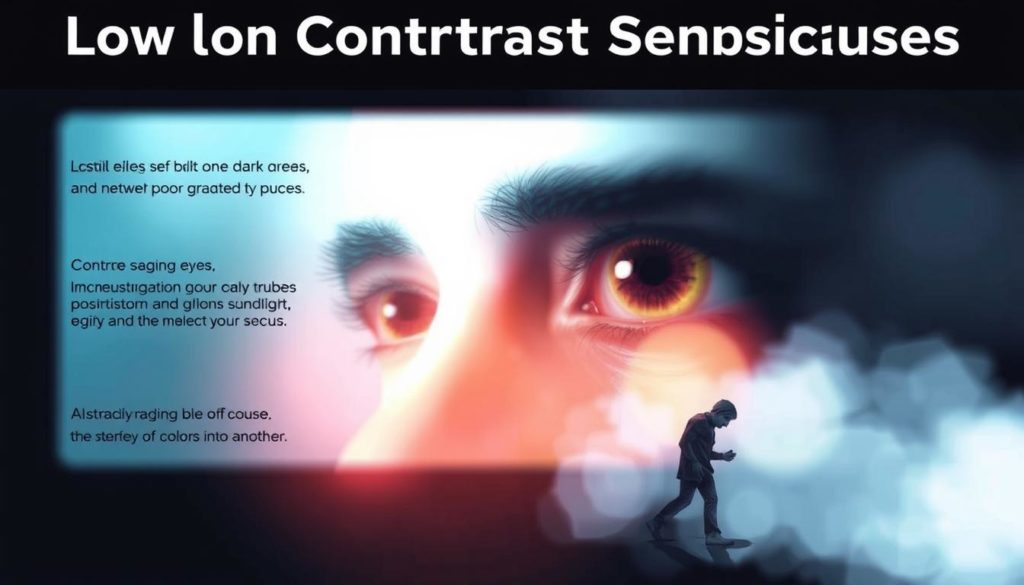Did you know that nearly 75% of people aged 60 and older face contrast sensitivity issues? This makes it hard for them to tell similar colors and shades apart. This fact shows how big of a problem visual contrast challenges are for many.
Contrast sensitivity is key for seeing the world around us. It helps us move, recognize faces, and enjoy the beauty of our surroundings. When it’s not working right, simple tasks become hard. Reading, driving at night, and seeing spatial differences can be tough, affecting our daily lives.
Visual contrast problems don’t just affect our physical activities. They also impact our mental and emotional well-being. People with these issues might feel frustrated, less independent, and isolated. It’s important to understand these problems to find ways to improve their lives. This article explores the causes, signs, and ways to manage contrast sensitivity issues, aiming to highlight their importance.
What is Contrast Sensitivity?
Contrast sensitivity is key to seeing objects against their background. It works well in different lighting.

Definition and Importance
Contrast sensitivity lets us see differences in brightness. It’s not just about sharpness, like visual acuity. It helps us see details, textures, and patterns.
In low light, like driving at night, it’s crucial. It lets us see faces in shadows. This skill is vital for daily life.
Difference from Visual Acuity
Knowing visual acuity vs contrast sensitivity is important. Visual acuity checks sharpness, like reading eye chart letters. Contrast sensitivity looks at seeing objects against different backgrounds.
Together, they give a full view of our vision.
Here’s a comparison:
| Aspect | Visual Acuity | Contrast Sensitivity |
|---|---|---|
| Definition | Sharpness of vision | Ability to distinguish objects from the background |
| Measurement | Eye chart letters | Grated patterns or brightness levels |
| Importance | Reading, detailed tasks | Low-light conditions, recognizing faces |
Causes of Contrast Sensitivity Issues
Understanding why we might have trouble seeing contrasts is key to keeping our vision healthy. Let’s explore the main reasons that affect our vision.
Age-Related Factors
As we age, our vision changes. The eye’s lens gets less clear and turns yellow. This makes it harder to see differences in shades. These changes can make contrast sensitivity disorders worse, affecting daily activities like driving at night or reading.
Ocular Diseases
Many eye diseases can lead to contrast sensitivity problems. Cataracts, glaucoma, and diabetic retinopathy are examples. Cataracts cloud the lens, scattering light and reducing clarity. Glaucoma damages the optic nerve, narrowing the field of vision. Diabetic retinopathy harms retinal blood vessels, severely impacting contrast sensitivity. Treating these diseases is vital for managing contrast sensitivity disorders.
Neurological Conditions
Neurological diseases can also affect contrast sensitivity. Conditions like multiple sclerosis and Parkinson’s disease impact the visual pathway. Multiple sclerosis damages optic nerve fibers, reducing vision and contrast perception. Parkinson’s disease, caused by dopamine deficiency, can also cause vision problems. This highlights the importance of neurological health for good vision.

| Factor | Impact on Contrast Sensitivity | Details |
|---|---|---|
| Age | Decreases | Yellowing of the lens, reduced transparency |
| Cataracts | Severely decreases | Clouding of the lens, light scattering |
| Glaucoma | Narrows vision field | Optic nerve damage |
| Multiple Sclerosis | Decreases | Demyelination of optic nerve fibers |
| Parkinson’s Disease | Decreases | Dopamine deficiency |
Identifying Low Contrast Sensitivity
It’s key to spot low contrast sensitivity to keep your vision sharp and stay safe. Knowing the symptoms of low contrast sensitivity and the vision problems it brings helps you get help fast.
Common Symptoms
People with low contrast sensitivity might show a few signs. These signs include:
- Difficulty seeing in dim lighting conditions
- Struggling to distinguish between similar colors
- Frequent eye strain
These signs can really affect your life. Spotting low contrast sensitivity means noticing small changes, like being more careful in dim places.
Everyday Challenges
Low contrast sensitivity can make daily tasks hard. Here are some common problems:
| Activity | Challenges Faced |
|---|---|
| Driving at Night | Difficulty perceiving other vehicles or road markers |
| Reading | Struggling with print that blends into the background |
| Navigating Unfamiliar Environments | Frequent stumbling or bumping into objects |
Understanding the vision problems linked to low contrast sensitivity is vital. Early detection and action can make your life safer and better.
Contrast Sensitivity Testing
Contrast sensitivity testing is key to seeing light and dark in images. It’s different from regular vision tests that check how well you see. This test shows how well you can see differences in brightness.
Types of Tests
There are many tests to check contrast sensitivity. The Pelli-Robson chart and the Functional Acuity Contrast Test (FACT) are common. These tests show letters or patterns at different contrast levels. They help figure out how well you see contrast.
- Pelli-Robson Chart: This chart has letters that get harder to see as they fade. It helps find out how well you can read faint letters.
- FACT: The FACT uses patterns to test how well you see in different conditions. It checks your vision in various situations.
Procedure and What to Expect
The test is easy and doesn’t hurt. Here’s what happens during the test:
- Preparation: You’ll learn about the test and might need to take off glasses.
- Testing Environment: The test is done in a bright, controlled area for best results.
- Execution: You’ll look at letters or patterns that get less clear. This is with the Pelli-Robson chart or FACT.
- Duration: The whole test takes about 10 to 20 minutes.
- Results: A doctor will look at your results. They compare them to what’s normal to see if you have any issues.
Contrast sensitivity testing is important for eye health. It helps find problems that regular tests might miss. It’s used in clinics and at home to check vision.
Impact of Contrast Sensitivity Issues on Daily Life
Contrast sensitivity issues affect more than just seeing shadows and outlines. They make simple tasks like reading labels and moving around in the dark hard. These issues really change how we see the world and our quality of life.
People with low contrast sensitivity find it tough to do their jobs well. They struggle to see small color differences or details in documents. This can make their job harder and less fulfilling.
These issues also make social activities hard. Driving at night, going to evening events, or playing sports can be tough. This can lead to feeling left out and lonely, hurting our happiness.
“I realized how deeply contrast sensitivity issues affected my vision and quality of life when I struggled to see my children’s expressions during a candlelit dinner,” reflects one affected parent.
Dealing with these problems requires finding ways to adapt and getting help. Occupational therapy and special training can help with daily tasks. Support groups also offer a place to share experiences and find support.
Here are some helpful strategies:
- Use brighter lights and high-contrast colors.
- Try vision therapy.
- Join support groups and seek counseling.
Here’s a quick look at resources for contrast sensitivity issues:
| Resource Type | Description |
|---|---|
| Occupational Therapy | Helps with adapting home and work environments. |
| Support Groups | Provides emotional and social support. |
| Visual Aids | Includes tools like high-contrast glasses and magnifiers. |
It’s important to understand how contrast sensitivity issues affect people. This helps us be more supportive and improve their lives.
Strategies to Improve Contrast Sensitivity
Improving contrast sensitivity can make daily life better, especially for those with vision problems. Diet, exercises, and visual aids are key to this improvement.
Diet and Nutrition
Eating right is vital for better contrast sensitivity. Foods high in vitamins A, C, and E, along with zinc and omega-3s, are great for the eyes. Here are some good choices:
- Carrots and sweet potatoes for vitamin A
- Citrus fruits and green leafy vegetables for vitamin C
- Nuts and seeds for vitamin E
- Fish such as salmon and mackerel for omega-3s
Eye Exercises
Eye exercises can naturally boost contrast sensitivity. Adding these to your routine can improve your vision. Here are some exercises to try:
- Focus Shifting – Switching focus between near and far objects.
- Palming – Rubbing hands together then placing them over closed eyes to relax.
- Exposure to Different Lighting – Getting used to different light levels to improve eye adaptability.
Use of Visual Aids
For serious contrast issues, visual aids are a big help. Special glasses or software can make tasks easier. Here are some options:
- High-contrast computer screen settings
- Contrast-enhancing lenses
- Mobile apps to improve visual contrast on screens
Contrast Sensitivity Function and Assessment
Understanding the contrast sensitivity function (CSF) is key for a full vision check. CSF shows how well you see contrast at different levels. It’s about spotting objects against different backgrounds, like driving at night or seeing faces in a crowd.
To check CSF, several methods are used. These include showing patterns with different contrasts and frequencies. One way is with sinusoidal gratings, which are like waves that change in frequency and contrast.
It’s vital to check CSF often, especially for older people or those with eye diseases. This helps eye doctors manage vision problems better. They can spot issues early and act fast if needed.
| Technique | Procedure | Significance |
|---|---|---|
| Sinusoidal Gratings | Patterns with varying frequencies and contrasts | Determines minimum contrast for detection |
| Pelli-Robson Chart | Letters of decreasing contrast | Easy and quick, used in clinical practice |
| Functional Acuity Contrast Test (FACT) | Detecting orientations of gratings | Detailed analysis of contrast sensitivity across multiple conditions |
By using a detailed approach to CSF, we get a better view of vision. This helps in making better treatment plans. It’s important for keeping and improving vision health for everyone.
Contrast Sensitivity in Children
It’s key to understand how contrast sensitivity affects kids’ vision. Early help can greatly improve their sight and learning skills.
Early Detection
Spotting contrast sensitivity problems early is vital. Look out for signs like trouble reading, squinting a lot, and color or shade confusion. Regular eye checks in kids can catch these issues early, leading to quick action.
Management Strategies
Helping kids with contrast sensitivity needs special plans. These include:
- Educational Accommodations: Making classroom settings better, like using high-contrast materials and big, clear fonts.
- Specialized Learning Materials: Using tools like books and apps that help with seeing better.
- Regular Follow-Ups: Eye doctors keeping an eye on how kids are doing and making changes as needed.
By starting with early eye checks and using tailored plans, kids with contrast sensitivity can do well in school and with friends.
Future Research and Developments
As we move forward in vision science, new research on contrast sensitivity is revealing exciting findings. Scientists are studying the causes of contrast sensitivity problems to find new treatments. They aim to improve how our eyes handle contrast, helping those with low sensitivity.
New technologies are leading these breakthroughs. For example, vision therapy now uses virtual reality and machine learning. These tools promise to greatly help people with contrast sensitivity issues.
This research brings together experts from neuroscience, optometry, and psychology. By working together, they create detailed plans to tackle visual perception challenges. This approach not only deepens our knowledge but also leads to practical treatments for everyday life.
FAQ
What is contrast sensitivity?
Contrast sensitivity is how well we see objects against their background. It matters a lot in low light. It helps us see details, textures, and patterns.
How does contrast sensitivity differ from visual acuity?
Visual acuity is about how sharp our vision is. Contrast sensitivity is about seeing light and dark differences. Both are key to good vision but in different ways.
What causes low contrast sensitivity?
Low contrast sensitivity can come from getting older, eye diseases like cataracts, or neurological issues. It can also be due to genetics or the environment.
How can I identify if I have low contrast sensitivity?
Signs include trouble seeing in dim light and trouble telling similar colors apart. It can also make you clumsy in low-contrast places. These issues can make daily tasks hard, like driving at night or reading.
What types of tests are available for assessing contrast sensitivity?
Tests like the Pelli-Robson chart and the Functional Acuity Contrast Test (FACT) are used. They can be done in clinics or at home to check your contrast detection.
How do contrast sensitivity issues impact daily life?
It can make driving, recognizing faces, and reading harder. It can also affect work and social life. But, there are ways to adapt and get help.
Are there ways to improve contrast sensitivity?
Yes, you can improve it. Eating right, doing eye exercises, and using special glasses can help.
What is the contrast sensitivity function (CSF)?
The CSF measures how well you see contrast at different levels. It’s important for keeping an eye on your vision health, especially if you’re at risk.
How important is contrast sensitivity testing for children?
Testing for contrast sensitivity in kids is very important. It helps find problems early. This way, kids can get the right help, like special learning tools.
What future developments are researchers exploring for contrast sensitivity?
Researchers are working to understand and treat contrast sensitivity problems. New technologies and treatments are being developed. They’re looking at it from many angles, including science and psychology.


